
Jonathan Chu, Emery Lin

|
Children's Hospital Informatics Program Jonathan Chu, Emery Lin |
OverviewResearchers at the Children's Hospital Informatics Program (CHIP) have access to the full text of nearly 2,000 articles in electronic format, but have no effective way of organizing them. Meanwhile, the National Library of Medicine keeps a collection of metadata for these same set of articles in a database called Pub Med, but doesn't provide the actual articles. This site combines CHIP's resources with NLM's database to form an online collaborative bibliography. Researchers can upload articles and gain instant access to their metadata, perform comprehensive searches to easily find articles, and discuss and collaborate around them.Visit: http://bluelines.mit.edu |
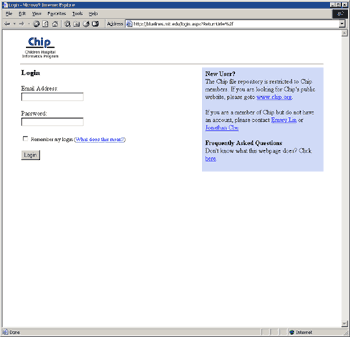 Chip Login Page (Larger Image) |
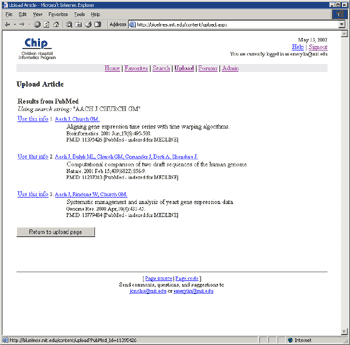 Article Upload Page (Larger Image) |
Uploading ArticlesA site won't be of much use if it doesn't contain any content. The upload facility on this site offers an array of options to the user. A user can always upload an article manually by providing a file and information like title, authors, and abstract. However, doing this for article after article can prove cumbersome. That's why the site offers two options that relieve the user of this burden: upload by text matching, and upload by Pub Med ID. Upload by Text MatchingThis option is the most ideal way to upload articles since it requires almost no involvement from the user. Once the user chooses an article to upload, the upload script automatically parses the text of the article and attempts to match it to an entry in the Pub Med database. The script returns a list of possible matches to the user. If the user finds a match, the metadata is extracted from the database and automatically inserted into the site database. This method returns the correct article nearly 80% of the time and will only improve as the text-extraction algorithms are refined. Upload by Pub Med IDShould upload by text matching fail, the user can provide a Pub Med ID. Once given this ID, the script automatically retrieves the article from Pub Med and inserts the metadata into the database. |
Searching for ArticlesWith such a large volume of articles in the database, it's important to have a robust search facility. This site provides both simple and advanced searches that allow a user to find articles easily, quickly and effectively. The simple search on the site performs a full-text search over all article metadata, including title, abstract, authors, and the full text of the article. Knowing just the smallest piece of information about an article allows a user to find it. Advanced users can improve searches by restricting queries to certain fields, dates, and keywords. |
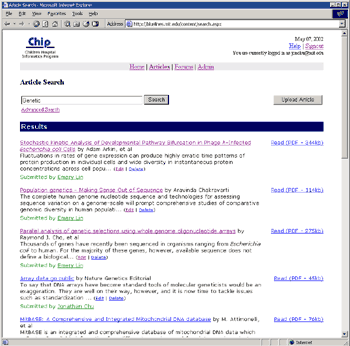 Search Engine
(Larger Image)
Search Engine
(Larger Image)
|
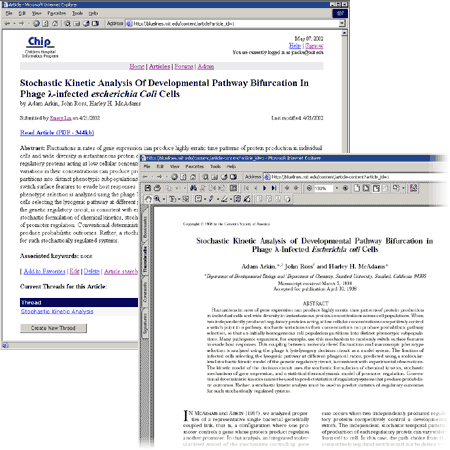 Editing an article
(Larger Image)
Editing an article
(Larger Image)
|
Reading and Collaborating around ArticlesYou've learned how to upload articles, and how to find them. Now it's time to use them. Every article on the site has its own personalized page that provides useful information about it. You can read the abstract to see if you might be interested in reading the whole article. You can see when it was published, who wrote it, and where they wrote it. Most importantly, you can also see what your peers have to say about it. All users are free to engage in discussions around and provide opinions about any article they're interested in. And every article has its own discussion section, so you only have to read about what you're interested in. |
PersonalizingThe personalization features of the site ensure that you'll never have to spend time looking for that article that you read yesterday but can't remember the name of. The site keeps track of your complete submission and viewing history so you don't have to. You can also bookmark your favorite articles so you can reference them quickly. |
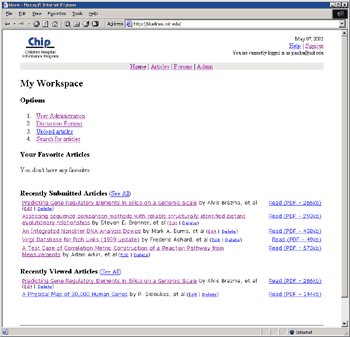 User workspace (Larger Image) |
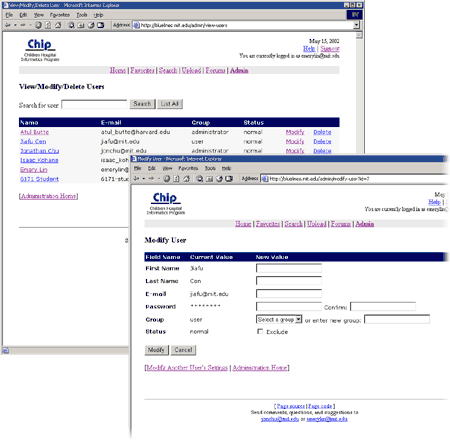 Modify User page
(Larger Image)
Modify User page
(Larger Image)
|
AdministrationTo keep the site running smoothly, administrators have complete control over everything on the site. With the site's user administration section, it's easy for an administrator add new users, reassign existing users to different groups, and modify user information if the need arises. Administrators can also maintain the article database from nearly anywhere on the site. Anywhere that articles are listed, administrators can modify an article's metadata, or delete it if it's not needed anymore. Administrators can also moderate all forum discussions. They can delete entire threads or individual comments if necessary |
Development on the Chip Intranet Site started in February 2002 and commenced in May. It was created by Jonathan Chu and Emery Lin, with constant guidance from Dr. Atul Butte and Dr. Isaac Kohane from CHIP, and Philip Greenspun, Andrew Grumet, and Hal Abelson from MIT.